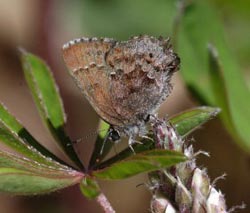Climate Change Affects the Flight Period of Butterflies in Massachusetts

Ernest Williams, Hamilton College<br> <br>The frosted elfin butterfly is one of the species covered in the study. <br>
In a new study, Boston University researchers and collaborators have found that butterflies show signs of being affected by climate change in a way similar to plants and bees, but not birds, in the Northeast United States.
The researchers focused on Massachusetts butterfly flight periods, comparing current flight periods with patterns going back more than 100 years using museum collections and the records of dedicated citizen scientists. Their findings indicate that butterflies are flying earlier in warmer years.
“Butterflies are very responsive to temperature in a way comparable to flowering time, leafing out time, and bee flight times,” says Richard Primack, professor of biology and study co-author. “However, bird arrival times in the spring are much less responsive to temperature.” As a result, climate change could have negative implications for bird populations in the Northeast, which rely on butterflies and other insects as a food source. The team, which includes Caroline Polgar (Boston University), Sharon Stichter (Massachusetts Butterfly Club), Ernest Williams (Hamilton College), and Colleen Hitchcock (Boston College) will publish its findings in the February 12 online edition of the journal Biological Conservation (http://www.sciencedirect.com/science/article/pii/S0006320712005228).
While the effect of climate change on plant and bird life cycles in eastern North America has been well examined, studies of the effects of climate change on insects are rare, so these findings represent an important contribution. This new study investigated whether the responses to climate warming in Massachusetts of ten short-lived butterfly species known as elfins and hairstreaks are similar to responses seen in plants, birds and bees. Another unique feature of this study is its use of data from museum collections as well as data gathered by the Massachusetts Butterfly Club, a group of dedicated citizen scientists who love butterflies. Use of this data gave the researchers an opportunity to compare butterfly flight periods dating back to the late 1800s.
The researchers obtained over 5000 records of butterflies in flight using museum collections (1893–1985) and citizen science data (1986–2009), then analyzed the data using statistical models to determine how butterfly flight times are affected by temperature, rainfall, geographic location, and year.
The researchers found that the start of the butterfly flight period advances on average by two days for each degree Fahrenheit increase in temperature. The response of these butterfly species to temperature is similar to plant flowering times and bee flight times and is significantly greater than bird arrival times, which increases the likelihood of ecological mismatches with migratory birds arriving after the first spring flush of their insect food.
The researchers also found that observations by citizen science groups such as the Massachusetts Butterfly Club were an effective and largely untapped source of information that could be used to investigate the potential impacts of climate change on butterflies. Such data provides an opportunity to inform conservation policies on these species and associated habitat. While data from museums was helpful, it was less abundant and therefore less useful than the citizen science dataset.
About Boston University—Founded in 1839, Boston University is an internationally recognized private research university with more than 30,000 students participating in undergraduate, graduate, and professional programs. As Boston University’s largest academic division, the College and Graduate School of Arts & Sciences is the heart of the BU experience with a global reach that enhances the University’s reputation for teaching and research. In 2012, BU joined the Association of American Universities (AAU), a consortium of 62 leading research universities in the United States and Canada.
Contact data for other authors: Caroline Polgar (carolinepolgar@gmail.com), Ernest Williams (ewilliam@hamilton.edu), Sharon Stichter (sharonstichter@comcast.net), and Colleen Hitchcock (colleen.hitchcock@bc.edu).
Media Contact
More Information:
http://www.bu.eduAll latest news from the category: Life Sciences and Chemistry
Articles and reports from the Life Sciences and chemistry area deal with applied and basic research into modern biology, chemistry and human medicine.
Valuable information can be found on a range of life sciences fields including bacteriology, biochemistry, bionics, bioinformatics, biophysics, biotechnology, genetics, geobotany, human biology, marine biology, microbiology, molecular biology, cellular biology, zoology, bioinorganic chemistry, microchemistry and environmental chemistry.
Newest articles

High-energy-density aqueous battery based on halogen multi-electron transfer
Traditional non-aqueous lithium-ion batteries have a high energy density, but their safety is compromised due to the flammable organic electrolytes they utilize. Aqueous batteries use water as the solvent for…

First-ever combined heart pump and pig kidney transplant
…gives new hope to patient with terminal illness. Surgeons at NYU Langone Health performed the first-ever combined mechanical heart pump and gene-edited pig kidney transplant surgery in a 54-year-old woman…

Biophysics: Testing how well biomarkers work
LMU researchers have developed a method to determine how reliably target proteins can be labeled using super-resolution fluorescence microscopy. Modern microscopy techniques make it possible to examine the inner workings…





















